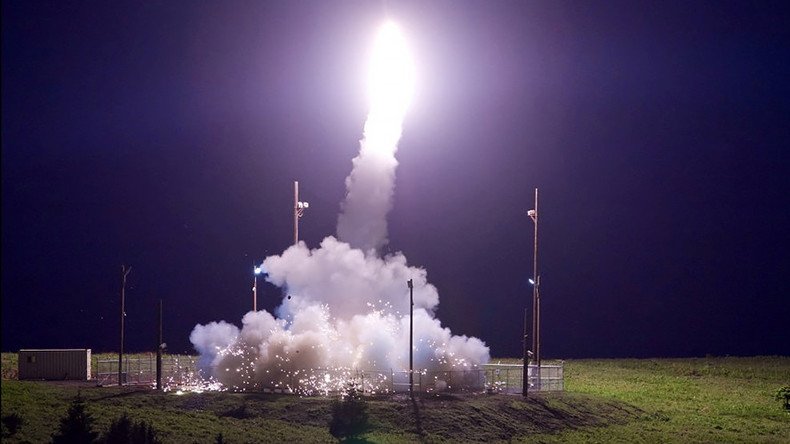Trump asks for another $4bn to ‘detect, defeat, & defend’ against North Korea

President Donald Trump wants lawmakers to give the Pentagon an additional $4 billion for “urgent” missile defense improvements against North Korea and nearly $2 billion more to increase troop levels in Afghanistan by 3,500 and repair damaged naval ships.
In a letter sent to House Speaker Paul Ryan (R-Wisconsin) on Monday, Trump asked Congress to consider budget amendments to give the Department of Defense an extra $4 billion for “defense enhancements to counter the threat from North Korea.”
“This request supports additional efforts to detect, defeat, and defend against any North Korean use of ballistic missiles against the United States, its deployed forces, allies, or partners,” Trump wrote in a letter to Congress.
Mick Mulvaney, director of the Office of Management and Budget, sent a letter to Trump on Friday, making a detailed request, which he said would be used to increase “critical capability and capacity” for the missile defense program.
The majority of the funds would be used to construct an additional ground-based interceptor (GBI) at Missile Field 4 in Fort Greely, Alaska and fund the initial procurement for the “eventual purchase” of 20 new GBIs.
The Ground-based Midcourse Defense (GMD) has the capability of detecting, tracking and intercepting long-range ballistic missile threats as far as outer space, according to the Missile Defense Advocacy Alliance (MDAA).
Missile Field 4 is one of the two ground-based missile defense units housing interceptors on the west coast. The unit was created to protect the United States from an intercontinental ballistic missile threat, according to the Pentagon.
There are currently 44 GBIs in Fort Greely, according to a declassified reprogramming request from the Pentagon. The additional 21 requested would bring the number of interceptors to 65.
The request would also go toward buying 16 new Standard Missile-3 Block IIA interceptors, which are designed to intercept intermediate-range ballistic missiles with a kinetic warhead that intercepts threats with the force of a 10-ton truck traveling 600 mph.
Additionally, the funds would go toward purchasing 50 more interceptors for the Terminal High-Altitude Area Defense (THAAD) interceptors, which provide the military with mobile systems to intercept intermediate-range ballistic missiles both inside and outside the atmosphere. THAAD interceptors have a range of about 200 kilometers and use “hit-to-kill” technology to destroy missiles in their terminal phase of flight.
Trump made the request while on a 13-day tour of Asia, just before he is set to arrive in South Korea on Tuesday.
Getting ready to leave for South Korea and meetings with President Moon, a fine gentleman. We will figure it all out!
— Donald J. Trump (@realDonaldTrump) November 6, 2017
While en route to Tokyo, Trump told reporters on board Air Force One that the US makes “the best military equipment in the world” and the $700 billion military budget is “going up.”
“A shot was just taken by Iran, in my opinion, at Saudi Arabia. You know about that, right? You saw the missile that went out? And our system knocked the missile out of the air. That's how good we are. Nobody makes what we make, and now we're selling it all over the world,” Trump told reporters on Air Force One, according to Axios.
US may not be capable of shooting down #NorthKorean missile – analysts https://t.co/kCNTpd3auEpic.twitter.com/I4nFYkjZAz
— RT America (@RT_America) September 20, 2017
Trump initially asked for $9.9 billion for missile defense for the fiscal year 2018, which was lower than the previous year. Then, in August, Trump said he would increase the missile defense program “by a substantial number of billions.”
“We’re going to be increasing our budget by many billions of dollars because of North Korea and other reasons having to do with the anti-missile [aspect],” Trump told reporters, then speaking from his private golf course in Bedminster, New Jersey.
The supplemental budget request also includes a request for an additional $1.2 billion to deploy 3,500 troops to the country to support his Afghanistan and South Asia strategy.
In August, Trump announced his administration's new strategy in Afghanistan and South Asia, which he said would have “a clear definition.”
“Our troops will fight to win,” Trump said. “From now on, victory will have a clear definition: attacking our enemies, obliterating ISIS, crushing al Qaeda, preventing the Taliban from taking over Afghanistan, and stopping mass terror attacks against America before they emerge.”
Trump also requested $700 million to repair the USS John S McCain and the USS Fitzgerald, two Navy ships that were damaged in fatal collisions over the summer. In his request, Trump said that the ships “provide critical naval presence and additional ballistic missile defense capabilities in the Asia-Pacific theater.”
Additionally, Trump asked lawmakers to provide $1.6 billion to build a wall along the US’s southern border with Mexico, writing that “the safety and security of the American people is my top priority.”
Senator John McCain (R-Arizona) and Rep. Mac Thornberry (R-Texas), the chairmen of the Senate and House Armed Services Committees, released a joint statement on Monday, saying that they “welcome the President’s amendment to his initial defense budget request and look forward to giving it the serious consideration it deserves.”
“The timely submission of this budget amendment means that the NDAA conferees will be able to consider this request in time to incorporate the additional funding into the final agreement,” the lawmakers wrote.













